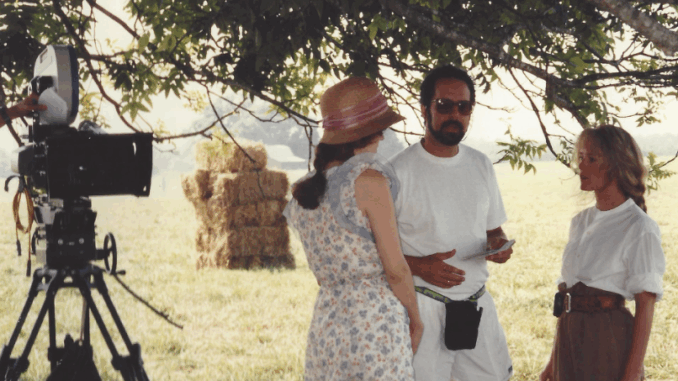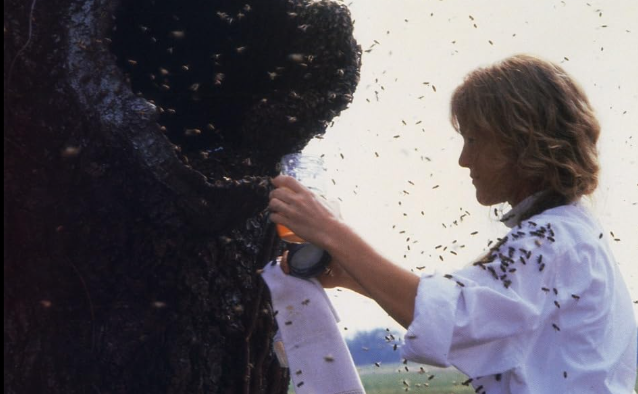
In the richly layered world of Fried Green Tomatoes, one seemingly small scene stands out as both whimsical and deeply symbolic: Idgie Threadgoode fearlessly reaching into a wild beehive to collect honey with her bare hands. It’s a striking moment — earthy, unexpected, and unforgettable. But beneath the buzz of bees lies something more: a metaphor for resistance, identity, and the sweetness found in freedom.
The Scene: Honey from the Hive
Early in the film, Idgie leads Ruth into the woods and climbs a tree where a massive beehive hangs. With complete calm, she inserts her hand into the swarm, extracts fresh honey, and offers it to Ruth. “I’m too young to die,” Ruth says nervously. But Idgie smiles, unbothered, and proves that she’s unafraid — not just of bees, but of life’s stings.
This scene is not just about bravery. It’s about claiming sweetness in a dangerous world.
Bees as a Mirror of Idgie’s Spirit
Bees live by their own rules — industrious, protective, wild when provoked, yet capable of great productivity. Idgie, too, lives outside the norms of her Southern society. She wears pants, runs her own business, defends Black friends, and refuses to marry. Like the bees, she guards her “hive” — the café, Ruth, and the community of Whistle Stop — with fierce loyalty.
The moment with the bees shows that Idgie is both in tune with nature and with herself. She’s not trying to conquer the hive; she’s part of it. It’s a beautiful metaphor for how she finds harmony in chaos.
Honey as Symbol of Nourishment and Love

Honey reappears subtly in the film — on café tables, in desserts, in kitchen scenes. It’s more than a sweetener; it becomes a symbol of healing and sustenance, especially in the bond between Idgie and Ruth.
The honey Idgie brings to Ruth isn’t just a gift — it’s a gesture of care, of offering something sacred. This is especially poignant considering Ruth is trapped in an abusive marriage at the time. The honey becomes a promise: there is still gentleness and safety in the world.
Bees and Queer Subtext
Though the film softens the romantic nature of Idgie and Ruth’s relationship, this scene — Idgie offering Ruth honey from a hive — has been widely interpreted as a coded love gesture. In queer readings of the film, the beehive becomes a stand-in for the taboo, the unspoken, the forbidden source of joy. Idgie doesn’t explain or apologize — she just offers it. And Ruth accepts.
In literature and folklore, bees have long been associated with femininity, secrecy, and same-sex devotion. The scene taps into those deeper resonances without needing to speak them aloud.
The Hidden Danger: Stings and Sacrifice
Bees don’t give honey freely. There is always risk. That too mirrors Idgie’s life — and the lives of all those who challenge social norms. She risks ostracism, violence, even death, to protect what she loves. But she reaches into the danger anyway.
This idea extends to other characters, too: Ruth risks everything to leave her husband; Sipsey and Big George face racism daily; Evelyn risks her comfort to change her life. The hive, like the world, is full of danger — but the honey is worth it.
Off-Screen Origins: Inspired by the Book
In Fannie Flagg’s original novel, Idgie’s bee-taming abilities are mentioned more than once, further connecting her to nature and the wild. The screenwriters retained this detail in the film because it visually and metaphorically encapsulates who Idgie is: a woman who belongs where others fear to go.
Director Jon Avnet has said in interviews that the bee scene was one of the most challenging and beautiful to shoot — and that Mary Stuart Masterson did interact with real bees on set, though with expert handlers present.
The Hive as Community
Ultimately, the bees aren’t just about Idgie — they represent the Whistle Stop community itself: buzzing, flawed, hardworking, and protective. Every person in the café is a worker in the hive, doing their part to preserve something sweet amid the bitterness of racism, abuse, and loss.
The hive is the symbol of found family, and honey — like love — is what they make together.
